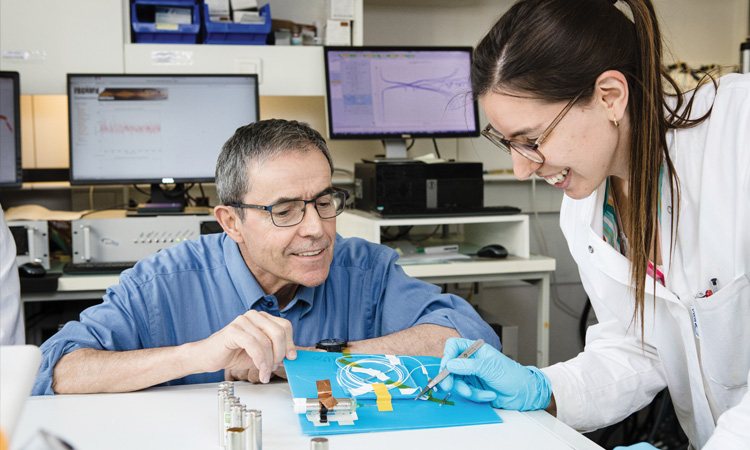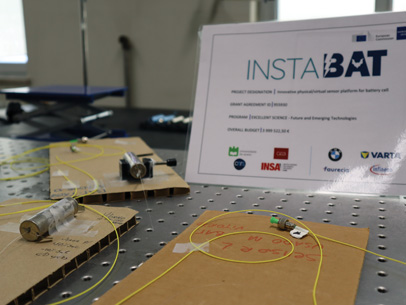 [3alexd / Getty Images]
[3alexd / Getty Images]
Over the last few years, the soft hum of electric vehicles (EVs) has become a familiar note within the urban soundscape. At its root, the switch to electric has been motivated by the urgent need to replace a global fleet of gas guzzlers with vehicles that minimize carbon emissions and reduce the health risks posed by air pollution. But more widespread adoption has also been enabled by ongoing advances in battery technologies and manufacturing processes, which have made the latest generation of EVs a more affordable and dependable option for a broader swath of motorists.
Driving this transport revolution is the lithium-ion battery, an invention that emerged from pioneering research by Nobel laureate Stanley Whittingham in the 1970s. Whittingham’s early work on rechargeable electrodes was transformed into the modern lithium-ion battery by further breakthroughs made in the 1980s by fellow Nobel laureates John Goodenough and Akira Yoshino.
By the 2010s, global production capacity of commercial lithium-ion batteries had reached a steady state of around 20 to 25 gigawatt-hours per year. But the International Energy Agency estimates that the recent shift toward EVs has boosted annual production from less than 50 GWh in 2016 to more than 500 GWh in 2022. Demand is expected to soar over the next decade as governments around the world act to phase out the internal combustion engine, with McKinsey & Company predicting that the global production capacity of batteries for EVs could reach 4700 GWh by 2030.
 Lithium-ion battery packs are the major component of a modern electric car, accounting for about one third of its overall cost. [kynny / Getty Images]
Lithium-ion battery packs are the major component of a modern electric car, accounting for about one third of its overall cost. [kynny / Getty Images]
Underpinning that growth have been ongoing innovations in battery design and manufacturing, which have reduced costs while also boosting the capacity, performance and lifetime of commercial systems. However, continuing that trajectory will require improved diagnostic techniques to help scientists and engineers understand what is happening inside a battery when it is repeatedly cycled through the charge-and-discharge process.
“The battery management systems in today’s EVs only measure the voltage, current and impedance, and even then only at the module level rather than for individual cells in the battery pack,” says Jean-Marie Tarascon, an expert in battery chemistry at the Collège de France in Paris. “That lack of diagnostic data prevents EVs from using the full capabilities of the available batteries, and also makes it difficult to establish appropriate safety margins.”
A myriad of characterization techniques has been exploited to untangle the underlying science of batteries, some of which are able to record information under real-world operating conditions.
Looking to optical sensors
In the laboratory, a myriad of characterization techniques has been exploited to untangle the underlying science of batteries, some of which are able to record information from commercial EV batteries under real-world operating conditions. Among these measurement technologies, optical fiber sensors are growing in popularity for their ease of integration, immunity to electromagnetic interference and ability to operate in harsh environmental conditions, and the opportunities they offer for measuring multiple parameters with high spatial and temporal resolution.
Sensors in focus
A number of different optical sensors have been exploited to probe the physical and chemical properties of batteries. The illustrations below represent just a few examples.
 Distributed fiber sensing measures the scattering of light along the continuous length of the fiber, with different types of scattering being sensitive to a range of physical parameters, including temperature and strain.
Distributed fiber sensing measures the scattering of light along the continuous length of the fiber, with different types of scattering being sensitive to a range of physical parameters, including temperature and strain.
 Fiber Bragg gratings are formed by inscribing a periodic pattern in the fiber core, creating a local change in refractive index that acts as a dielectric mirror. Changes in temperature, pressure and strain alter the wavelength of light reflected by the grating.
Fiber Bragg gratings are formed by inscribing a periodic pattern in the fiber core, creating a local change in refractive index that acts as a dielectric mirror. Changes in temperature, pressure and strain alter the wavelength of light reflected by the grating.
 In tilted fiber Bragg gratings, the periodic pattern is formed at an angle to the fiber core, which excites modes in the fiber cladding. These cladding modes are sensitive to refractive-index changes in the surrounding environment, an effect that can be amplified by coating the sensors with a metal film to excite surface plasmon resonance.
In tilted fiber Bragg gratings, the periodic pattern is formed at an angle to the fiber core, which excites modes in the fiber cladding. These cladding modes are sensitive to refractive-index changes in the surrounding environment, an effect that can be amplified by coating the sensors with a metal film to excite surface plasmon resonance.
 In evanescent-wave sensors, a short section of the fiber is tapered, removed or modified to enable more light to escape from the fiber and interact with the material surrounding the fiber.
In evanescent-wave sensors, a short section of the fiber is tapered, removed or modified to enable more light to escape from the fiber and interact with the material surrounding the fiber.
[Illustrations by Phil Saunders]
The type of optical sensor depends on the application. At the University of Warwick, UK, for example, battery engineer James Marco is working to combine hundreds or even thousands of individual cells into battery packs that can supply enough energy to power an EV. “My focus is on the cell-to-system scale-up, which means that we need an improved understanding of the thermal management, the mechanical loading on individual cells and the packaging requirements,” he says. “Our aim is to extend life and improve performance, while also reducing the cost and complexity of manufacturing battery packs for future cars and planes.”
For Marco and his team, it is particularly important to monitor the generation of heat within the cells and to understand how the hottest part of the battery moves during operation. “Batteries are becoming physically much larger, so we need to measure the spatial variation in temperature as well as how it changes over time,” he explains. “By wrapping fiber sensors around the cell, we can track the movement of the hotspot as the load profile changes and as the battery ages.”
Marco also uses fiber sensors to measure local variations in mechanical strain. “Batteries are breathing objects that expand and contract every time they charge and discharge, with the amount of swelling depending on the battery chemistry,” he says. “We need to quantify that expansion because cells that are packed closely together can generate high compressive forces within the system.”
The researchers exploit distributed optical sensors that use the fiber itself as the sensing medium, an approach that has widely been used in civil and mechanical engineering to monitor critical infrastructure such as electric cables and reservoir dams. These distributed sensors measure the scattering of light within the fiber, with different types of scattering being more or less sensitive to variations in temperature and strain along its length.
In the past, these surface measurements would typically have been recorded using a combination of thermocouples and strain gauges, but the fiber-based approach offers a simpler solution that requires fewer sensors. “In our setup we have two fibers running next to each other, one measuring temperature and the other measuring both strain and temperature,” he notes. “We can then cross-calibrate between the two to obtain independent measurements of each parameter, and then use the measurements to improve the accuracy of models that predict the behavior of the cells when they are integrated into battery packs.”
 Embedding an optical fiber inside a commercial lithium-ion cell makes it possible to measure both physical and chemical parameters under realistic operating conditions. [© F. PLAS / CSE / CNRS Images]
Embedding an optical fiber inside a commercial lithium-ion cell makes it possible to measure both physical and chemical parameters under realistic operating conditions. [© F. PLAS / CSE / CNRS Images]
Inside the cell
Other researchers are using optical fiber sensors to probe the complex internal dynamics of battery cells. Pioneering experiments by João Pinto’s group at the University of Aveiro, Portugal, first showed around a decade ago that fiber sensors operating inside commercial lithium-ion batteries can provide reliable and accurate temperature measurements during the cycling process. “Optical fibers are minimally invasive; they do not affect the performance of the battery and they are not affected by the chemical environment inside the cell,” says Micael Nascimento, a researcher in Pinto’s group. “With just one strand of fiber, we can create a multipoint sensor that provides a map of different physical parameters across the battery.”
Most of these studies have exploited fiber Bragg gratings (FBGs), a mature sensing technology in which a periodic variation in refractive index is inscribed (usually with lasers) within a short section of the core of a single-mode optical fiber. The local refractive-index variation acts to reflect a specific wavelength of light while transmitting all others. The wavelength of the reflected light varies in response to changes in temperature and strain, while multiple FBGs can be fabricated along the same length of fiber to provide multipoint and quasi-distributed sensing.
As an example, Nascimento and colleagues have exploited a network of FBG sensors to map the thermal behavior of three lithium-ion batteries inside a battery pack. Their results revealed the formation of hotspots that can degrade performance and potentially lead to thermal runaway, in which an exothermic chain reaction causes the battery to overheat, catch fire or even explode. “During thermal runaway events, the temperature inside the battery can reach 200°C, but it takes longer for the surface to heat up and the measured temperature will also be much lower,” explains Nascimento. “Embedding the sensors inside the battery provides faster and more accurate measurements.”
While FBGs are sensitive to multiple variables within the dynamic battery environment, scientists at PARC, a research consultancy in Palo Alto, CA, USA, showed that independent measurements of temperature and strain can be obtained with a pair of FBG sensors, one of which is enclosed in a special tubing to make it selectively sensitive to temperature. Isolating the effects of strain allowed the researchers to accurately estimate the battery’s state of charge under a range of operational scenarios, and even to predict the capacity of the cell up to 10 cycles ahead.
Meanwhile, Nascimento and colleagues have devised a scheme that decouples the effects of strain and temperature inside the battery using the same length of fiber, in this case by inscribing FBGs close to the air-filled cavity of a Fabry-Pérot sensor. “The open cavity in these sensors makes them sensitive to strain but not temperature,” explains Nascimento. “Integrating both technologies in the same fiber makes it possible to discriminate between these parameters while also enabling us to record the measurements at the same time and location.”
 Jean-Marie Tarascon (left) working at the Collège de France with a member of his laboratory team. [© F. PLAS / CSE / CNRS Images]
Jean-Marie Tarascon (left) working at the Collège de France with a member of his laboratory team. [© F. PLAS / CSE / CNRS Images]
Dynamic diagnostics
While temperature and strain remain the main target parameters, researchers have been exploring the potential of fiber sensors to measure other physical and chemical properties that affect battery performance and safety. One key goal, for example, is to understand the electrochemical processes that govern the growth of the solid–electrolyte interface (SEI), a passivation layer that forms on the surface of the positive electrode as the electrolyte decomposes during the very first few charging cycles.
While temperature and strain remain the main target parameters, researchers have been exploring the potential of fiber sensors to measure other physical and chemical properties.
“The quality of the SEI has an important influence on the lifetime and performance of the battery, which means that we need to understand the chemical processes that affect its evolution,” says Tarascon. “The electrolyte contains several additives, for instance, and it is important to know how each one decomposes and affects the formation of the SEI.”
Tarascon’s team has shown that optical techniques are able to decode some of these chemical signatures inside a commercial lithium-ion battery. By fabricating an FBG sensor within a microstructured optical fiber, known for its enhanced sensitivity to hydraulic pressure due to its air-filled internal structure, the researchers were able for the first time to obtain independent measurements of temperature and pressure variations across the cell. These data could then be combined with a thermal model to track local heat flows inside the battery.
Using this technique, which they call optical calorimetry, the researchers were able to infer the evolution of critical chemical events, such as the formation of the SEI and the onset of parasitic reactions that degrade battery performance. “This optical sensing technique provides access to all the thermal parameters that are important for batteries, and allows us to estimate the energy associated with the formation of SEI,” Tarascon explains. “It shows that optical measurements are sensitive to chemical changes inside the battery, although in this case we are still unable to determine which chemical species are involved in the process.”
More direct probes of the chemical behavior inside the battery require sensor designs that allow some of the light to escape from the fiber, creating evanescent waves that interact with the surrounding material over very short distances. Such evanescent fields can be created, for example, by fabricating an FBG at a slight angle to the fiber core, which excites modes in the fiber cladding that are influenced by the local environment.
Such tilted FBGs are particularly sensitive to changes in refractive index, an effect that can be further enhanced via a thin metal coating on the sensor, to excite surface plasmonic resonance. In one example, Tarascon and his team injected a tilted FBG into a commercial sodium-ion cell, which allowed them to track variations in local refractive index that could be related to chemical changes in the electrolyte. However, while such independent measurements of the refractive index can yield important insights into the physical and chemical dynamics inside the cell, they are still unable to reveal the chemical makeup of the battery environment.
Chemical insight
Accessing such rich chemical information requires the use of spectroscopic methods that probe the absorption of infrared light by different molecular species, an emerging technique that Tarascon’s team has recently shown can uncover real-time chemical processes inside commercial EV batteries. “With this new approach, we can detect the molecular signatures of chemical species in the electrode and electrolyte, and follow their evolution while the battery is being operated under realistic conditions,” explains Tarascon. “We can use that information to understand the origins of the SEI, the electrochemical behavior of new additives and the complex interactions between them.”
Measuring the infrared absorption spectra once again relies on the use of evanescent waves, in this case by using an unclad fiber that enables the full evanescent field to extend beyond its surface and interact with the surrounding material. However, conventional silica fiber is not transparent to the mid-infrared wavelengths that are absorbed by the chemicals inside batteries, so the team instead fabricated its sensing system from a chalcogenide glass that effectively shifts the transparency toward mid-infrared wavelengths.
In their experiments, the researchers inserted the chalcogenide fiber into both lithium-ion and sodium-ion cells and recorded infrared absorption spectra over multiple charge-and-discharge cycles. Their analysis revealed dynamic chemical changes in the electrolyte as the voltage and current were varied, enabling the decomposition mechanism of a common additive to be tracked during the initial charging cycle of the battery. By coating the fiber with a carbon composite electrode, it was also possible to measure the absorption spectra of the cathode materials, providing new insights into the dynamics of lithium uptake and removal as the cells are charged and discharged.
 The INSTABAT project is creating a multisensing platform that can be integrated with a battery management system to provide real-time monitoring of key battery indicators. [INSTABAT]
The INSTABAT project is creating a multisensing platform that can be integrated with a battery management system to provide real-time monitoring of key battery indicators. [INSTABAT]
Relating measurements to performance
In reality, the design and manufacture of improved EV batteries will require a combination of sensing modalities linked to algorithms and models that relate the measurements to key indicators of battery performance. Providing such comprehensive diagnostics is the key goal of the INSTABAT project, an EU-funded initiative building a smart sensing platform that can be integrated into a battery to provide real-time monitoring of both chemical and physical processes.
As part of this “lab-on-a-cell”, Nascimento and colleagues are developing an FBG sensor capable of providing independent measurements of temperature, strain and pressure, while another optical probe being engineered by researchers at the French Alternative Energies and Atomic Energy Commission (CEA) will exploit fluorescent materials at the tip of the fiber to monitor changes in temperature and lithium concentration during cycling. These will be coupled with a photoacoustic sensor to measure internal levels of carbon dioxide, plus a reference electrode to record the battery potential.
The research consortium is also designing two virtual sensors that will correlate the physical measurements to thermal and electrochemical processes that influence the battery’s lifetime and performance. “We are trying to gain a better understanding of the internal dynamics of the battery,” explains Nascimento. “Combining the physical measurements with models of physical and chemical behavior that cannot be detected directly will improve the accuracy of key indicators, such as the safety, health and charging capacity of the cell, and will inform the design of new materials and battery technologies.”
Meanwhile, the long-term dream is to integrate such information-rich monitoring systems into the battery management systems of commercial EVs. Current battery packs might be fitted with thermocouples to measure the external temperature of the battery module, but such sparse diagnostic data do not provide any meaningful insight into the health of the battery or rapidly escalating thermal events that are likely to pose a safety risk.
The biggest barrier for battery designers is the cost of adding more sensors into the battery system—which already accounts for about a third of the cost of an electric vehicle.
That lack of information also degrades the sustainability of this zero-emission technology, since the battery packs are typically discarded when an EV reaches the end of its life. More comprehensive diagnostics over the battery’s lifetime might enable the batteries to be recycled or repurposed into less-demanding applications, such as offline grid storage and lower-speed vehicles. “If you really want to recycle batteries and give them a second life, you need to know their history,” says Tarascon. “Real-time access to accurate diagnostic data will also be important for future applications in which EV batteries could be used to supply energy back to the grid.”
However, the biggest barrier for battery designers is the cost of adding more sensors into the battery system—which already accounts for about a third of the cost of an EV. While the most mature FBG technologies are now relatively inexpensive, the electronic interrogation systems needed to convert optical signals into useful data still cost tens of thousands of dollars.
 Better batteries could make electric vehicles an option for a broader swath of motorists. [martin-dm / Getty Images]
Better batteries could make electric vehicles an option for a broader swath of motorists. [martin-dm / Getty Images]
Toward better batteries
There will be no quick fix, but several different strategies have been proposed to bring the cost down. For example, as Tarascon and colleagues note in a recent perspective article, commercial optical interrogators often exceed the requirements of battery applications, which means that downgrading parameters such as the wavelength range and acquisition frequency could lower the cost per sensor channel. The potential of this approach was demonstrated by the scientists at PARC, working in collaboration with Korean company LG, who have reported low-cost and compact readout units for FBG sensors that can resolve wavelength shifts as small as 50 fm at 100 Hz.
The PARC team also showed that multiplexing techniques can enable hundreds of FBG sensors to be monitored from a single compact unit. They suggest that implementing this type of multiplexed design on a mass-produced photonic optical chip could reduce the price to a few hundred dollars, which would provide an affordable and compact on-chip interrogator for onboard sensing.
As a demonstrator project, Tarascon and his team are also building a battery pack with integrated FBG sensors for measuring the internal temperature of the cells. They have already designed and built compact interrogators that can monitor several different fibers, and they are now working to create a digital twin to extrapolate the sensor data from one battery to 10 or 15 other devices. “For practical applications, it will not be possible to put a sensor into each cell,” says Tarascon. “Virtual models based on more accurate physical measurements can help battery manufacturers to produce higher-quality batteries, while also offering a promising route toward improved real-time diagnostics.”
In the short term, however, Tarascon believes that the most practical scenario will be to introduce a small number of single-measurement sensors into key locations inside the battery pack. “Key-point sensing requires many fewer sensor points, which lowers both the cost and complexity,” he says. “Positioning the sensors on the surface of the cells may be the first step for commercial applications, although the most benefit should ultimately be realized by implanting the sensors into the cells.”
Susan Curtis is a freelance science and technology writer based in Bristol, UK.
References and Resources
-
J. Huang et al. “Sensing as the key to battery lifetime and sustainability,” Nat. Sustain. 5, 194 (2022).
-
X. Lu et al. “Perspective on commercializing smart sensing for batteries,” eTransportation 14, 100207 (2022).
-
M. Nascimento et al. “Thermal mapping of a lithium polymer batteries pack with FBGs network,” Batteries 4, 67 (2018).
-
A. Raghavan et al. “Embedded fiber-optic sensing for accurate internal monitoring of cell state in advanced battery management systems (parts 1 and 2),” J. Power Sources 341, 466 and 474 (2017).
